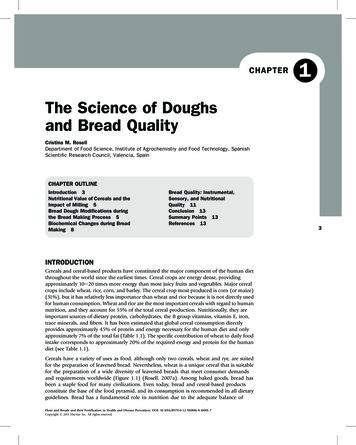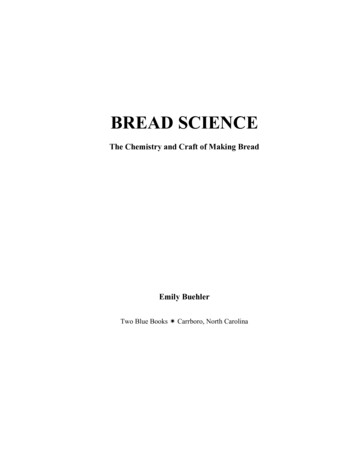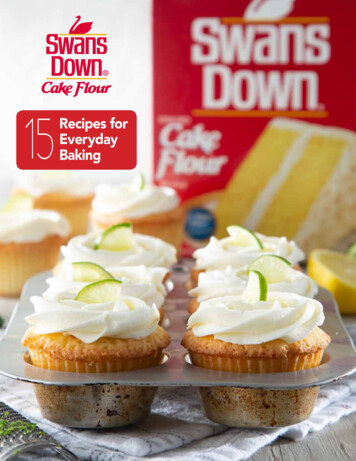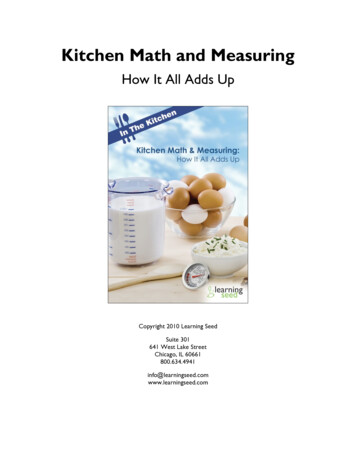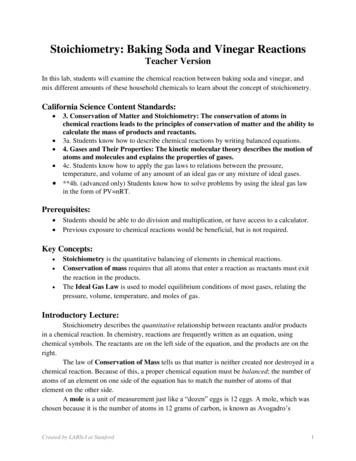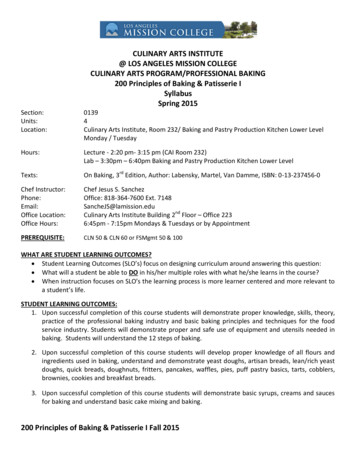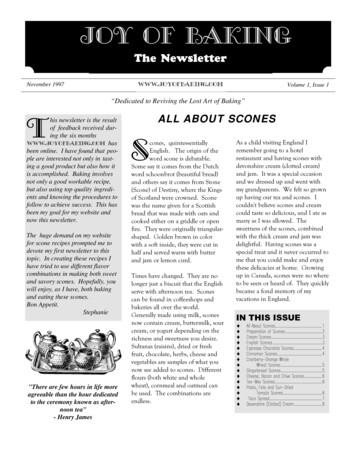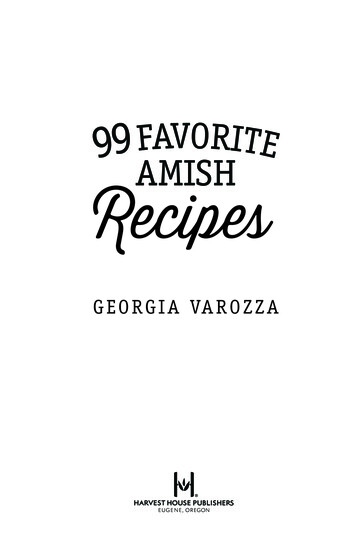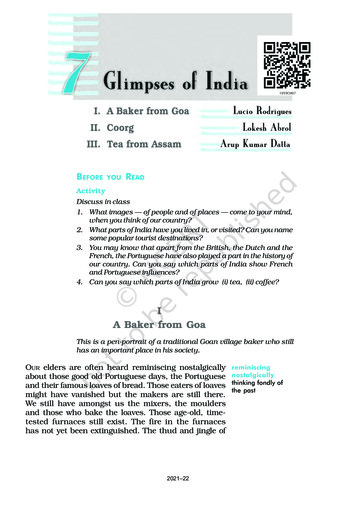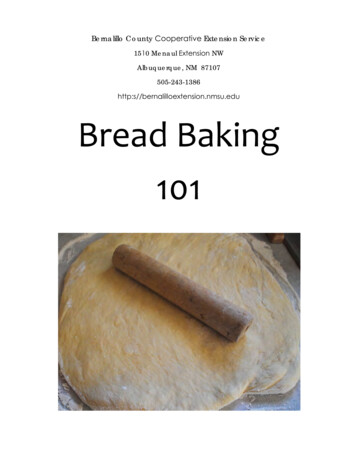
Transcription
Bernalillo County Cooperative Extension Service1510 Menaul Extension NWAlbuquerque, NM eduBread Baking101
Email: csdavies@ad.nmsu.edu
Table of ContentsBread Baking 101 . 1How to Adjust Yeast Bread Recipes for High Altitude . 1Using a Bread Machine. 3Bread Machine Troubleshooting Guide . 3Yeast Dinner Rolls .7French Bread . 8Grassy Creek Multigrain Bread . 9Whole Wheat Hot Roll Mix & Pan Rolls. 11Whole Wheat Bran Bread.12No Knead Whole Grain Bread .13Bread Sticks.14English Muffins . 15Anadama Bread .16Cinnamon Rolls .17Pizza Dough .19Refrigerator Bran Rolls .20Artisan Bread in 5 Minutes a Day .21Croissants.23Quick Bread.27Quick Bread Leavening Adjustments .27Additional High‐Altitude Adjustments .27i
Table of Contents(continued)Cranberry Orange Scones .29Lemon Blueberry Scones .30Bacon‐Cheddar‐Chive Scones .31Sour Cream Coffee Cake . 32Extraordinary Buttermilk Biscuits .33Cheese Straws.34ii
Bread Baking 101Who doesn’t love the smell of bread baking in the oven? It evokes afeeling of comfort, coziness, and well‐being. From a hearty, whole‐grain loaf to buttery, rich croissants or tender biscuits to tastyscones, we all have our weaknesses — I mean, our preferences!High altitude bread baking doesn’t have to be hard, time consum‐ing, or tricky. Once you learn the basics, you can use your newfound knowledge to bake all kinds of breads — yeast breads, quickbreads, sweet breads, and savory breads.Following are some basic adjustments for both yeast breads andquick breads. The key is to keep a baking journal so you will knowwhich adjustments work best for your location. And keep practic‐ing!How To Adjust Yeast BreadRecipes for High Altitude1) Decrease the amount of white flour in the recipe. You may needto use up to 1/4 less flour than the recipe calls for because flour los‐es moisture at high altitude which creates a dry‐tasting finishedproduct. You'll know there is enough moisture your high altitudebread dough when the mass pulls away from the sides of the bowl.Suggestion: Gradually add flour 1 tbsp. at a time if the batter is toowet or sticky2) Increase the amount of liquid in the recipe if using wheat or ryeflour. Add 1 tbsp. or more than the recipe calls for. These coarseflours lose even more moisture than white flour does at altitude.1
3) Add additional liquid, 1 tbsp. at a time, if the dough seems toodry. Your dough should be soft, moist and pull away from thesides of the bowl after re‐kneading.4) Add an additional rising cycle. Good tasting bread depends ona long, slow rising process but bread dough rises as much as 25%to 50% faster in high altitude locations. Bread dough that rises rap‐idly will have a strong yeast‐flavor and a dry texture. For the bestflavor, allow enough time for 2 separate rising cycles and never letthe dough rise more than twice its size each time.Suggestion: Reduce the amount of rising time the recipe calls forby about 15 minutes or until the bread has reached nearly twice itssize.Punch down your dough after the first rising cycle is over. Set intoa bowl and allow it to rise again but for half the time of the firstcycle.5) Subtract 1 degree of baking temperature for every 500 feetabove sea level. At altitude, heat molecules don't have enoughenergy inside them which results in a lower boiling point but alsomakes food take longer to cook. Baking at a higher temperaturewill set the bread structure quickly and stop dough from risingmore.6) Use less yeast if all other altitude baking adjustments fail toprovide firm bread dough that doesn't collapse after rising andbaking.Suggestion: Reduce the yeast by 1/8 tsp. to see if you get a firmerbread dough. If you are unhappy with your finished bread, de‐crease yeast by another 1/8 tsp. each time you attempt the recipeuntil you are happy with the finished product.2
Using A Bread MachineBread machines are making a comeback into the culinary world!There are many beautiful, new (and improved!) bread machineson the market today. Also, you can almost always find a good,used bread machine at your local thrift store or yard sale. If youhappen to buy a used machine that does not have an instruction‐al booklet, or you have lost yours, a good resource to check out eBread Machine Troubleshooting Guide1) Top inflated, mushroom‐like appearance:Possible cause — Too much yeast Too much sugar Not enough salt Substituted fast‐acting yeast for amount given for active dryyeast Yeast was not added according to manufacturer’s directionsSolution — Decrease yeast or sugar in recipe Try adding a little more salt If substituting fast‐acting yeast for active dry, decreaseamount by 1/4 to 1/2 teaspoon3
Bread MachineTroubleshooting Guide, continued2) Top and sides cave in:Possible cause — Too much liquid Used canned fruit but did not drain well Liquid off‐balanced by addition of cheese Used coarser flours such as whole wheat or ryeSolution — Try reducing liquids 1 tablespoon at a time If using more than half coarse flour, try increasing yeast slight‐ly or reducing coarse flour and increasing bread flour3) Soggy sides:Possible cause — Did not removed bread from pan soon enoughSolution — If possible, remove bread immediately when baking is finished4) Center of loaf is raw or not baked through:Possible cause — Used coarse flours such as whole wheat or rye Used moist ingredients such as yogurt or applesauceSolution — For coarse flours, try adding an extra knead cycle. To do this,after the first knead, let dough rise then restart machine at thebeginning of the cycle as for a new loaf If too many moist ingredients are used, try reducing liquids 1tablespoon at a time4
Bread MachineTroubleshooting Guide, continued5) Gnarly, knotted loaves:Possible cause — Not enough liquid Too much flourSolution — Increase liquid 1 tablespoon at a time or reduce flour 2 table‐spoons at a time6) Didn’t rise or flat loaves:Possible cause — Yeast was omitted Yeast was old Liquid used was too hot or too cold Too much salt was usedSolution — Make sure yeast is fresh Make sure to use room temperature water Taste the bread to see if it is too salty; if so, reduce salt by 1/4teaspoon at a time5
Bread MachineTroubleshooting Guide, continued7) Lower volume or shorter loaves:Possible cause — Used stone ground and whole wheat flours Not enough liquid Not enough sugar or no salt added Wrong type of flour used Wrong type of yeast used Not enough yeast usedSolution — Try substituting bread flour for part of the stone ground orwhole wheat flour Try adding more liquid, sugar or yeast Check to make sure bread flour, not all‐purpose flour, was used Check to make sure yeast amount suggested was for the typeof yeast you were using8) Collapsed while baking:Possible cause — May be cause from baking in high altitudeSolution: Try reducing yeast by 1/4 teaspoon or reducing water by 2 table‐spoons6
Yeast Dinner Rolls—start with something easy!Ingredients: 1 package active dry yeast1 tsp sugar1/2 cup warm water2/3 cup sugar3 Tbsp shortening3 eggs5 to 6 cups flour1 teaspoon saltInstructions:Mix yeast, sugar, and warm water. Set aside in warm place; allowto rise and bubble up. While waiting for yeast mixture, cream 2/3cup sugar with 3 heaping tablespoons shortening. Beat in eggs,one at a time.Sift 5 to 6 cups flour and salt. Add yeast mixture to creamed mix‐ture, plus 1‐1/2 cups warm water. Add flour until dough is right tex‐ture for bread. Turn into large greased bowl, cover, and allow torise until doubled in size (about 2 hours).Once dough has risen, turn out onto floured surface and kneadbriefly. Roll dough to desired thickness then cut with a biscuit cut‐ter or glass. Place in greased pans, and let rise 60 to 70 minutes.When rolls have risen well, bake for approximately 15 to 20minutes in preheated 400º oven. If rolls seem to be browning tooquickly, cover with foil and continue baking until done.7
French BreadIngredients: 1 1/4 cups warm water (add more water, by tablespoons, untilbread dough is moist) 1 packet active dry yeast (less 25%, if you're at high altitudes of5,000 feet or more.) 1 tablespoon honey1 tablespoon shortening, melted1 1/2 teaspoons salt3 1/2 cups flourInstructions: Combine ingredients in the order listed above. Add flour last.Begin with 3 cups. Place 1/2 cup on your bread board and kneadthis into the dough. If the dough is very sticky, add additionalflour 1/4 cup at a time. Rising time: approximately 1 hour. 400 degree oven. Bake for30 minutes. Brush loaf with beaten egg white and water mix‐ture, for a crispier crust.8
Grassy Creek MultigrainBread(recipe adapted from “Pie in the Sky”)Note: Adjusted for an altitude of 5,000 to 7,000 feetIngredients: 2 1/4 teaspoons active dry yeast 1/4 cup warm water 1 Tablespoon granulated sugar 1/2 cup plus 2 Tablespoons water 1/2 cup plain yogurt, low‐fat or regular 1 1/4 teaspoons salt 2 Tablespoons olive or canola oil 3 Tablespoons honey 2 1/3 cups unbleached white bread flour 1/2 to 3/4 cup whole wheat flour 1/2 cup spelt flour 1/4 cup wheat germ, toasted or plain (plus some forsprinkling on top) 3 Tablespoons flaxseed meal or ground seeds 3 Tablespoons flaxseed or sesame seeds 1/4 cup sunflower seeds or chopped walnuts 1 Tablespoon poppy seeds, optional9
Grassy Creek Multigrain Bread, continuedInstructions:1) In a small bowl, combine the yeast, warm water, and sugar.Stir, and set aside for 3 to 4 minutes, until mixture bubbles up.2) Combine the 1/2 cup plus 2 Tbsp. water, yogurt, salt, oil, andhoney; heat until just hot to the touch (115º to 120ºF). Cool tolukewarm.3) In the large bowl of an electric mixer, toss together all theflour, wheat germ, and seeds or nuts. Stir in the bubblingyeast mixture. Stir liquid mixture into the flour and yeast.4) With the paddle attachment, beat the dough slowly until it iswell blended and the gluten begins to develop (about 5 to 7minutes). The dough will look quite rough; if it feels verysticky, sprinkle on another 2 to 3 Tbsp. bread flour and beat.5) Switch paddle to dough hook and place mixer on lowestspeed. Knead until it forms a cohesive ball and is no longersticky to the touch, about 6 to 7 minutes, adding another 2 or3 Tbsp. flour if necessary. Form dough into a ball6) Place dough in an oiled bowl or 2‐gallon Ziplock bag; turn onceto coat with oil. Seal the bag, or cover the bowl with wrap.Place in a warm spot free from drafts. Allow to double in size.7) Punch down dough to remove large air bubbles and turn ontoa lightly floured surface; knead once or twice and return to theoiled container. Allow to rise 35 to 40 minutes.8) Punch down dough, knead once or twice, and then form itinto a round smooth ball. Place ball on parchment lined cook‐ie sheet (or sprayed with Pam); cover loosely with oiled plasticwrap. Allow to rest 15 to 20 minutes. Preheat oven to 400ºF.9) Position oven rack in center; place pan of hot water on lowerrack. Glaze bread with egg wash (1 egg plus 1 tsp. water); slashwith sharp knife and sprinkle with wheat germ.10) Bake 15 minutes; reduce to 375º; bake 25 to 35 min., removingwater after ten minutes at 375º. Cool before slicing.10
Whole Wheat Hot Roll Mix 9 cups all purpose flour 9 cups whole wheat flour 5 packages 50% faster yeast 1 Tablespoon salt 1 cup instant dry non‐fat milk 1 cup sugar Combine all ingredients and mix thoroughly in a large container.Store in an airtight container in a dark, dry, cool place.Whole Wheat Pan Rolls 1 ½ cup lukewarm water ½ cup vegetable oil or melted butter or margarine 2 eggs, beaten 5 to 6 cups basic Whole Wheat Hot Roll Mix (above) Combine water, eggs and oil in large bowl. Add 5 cups of hotroll mix. Blend well (add additional mix to make a soft, but nottoo sticky dough) Knead dough about 5 minutes until dough is smooth. Lightlygrease a bowl. Put dough in bowl and turn greased side up. Cover dough with a warm damp towel and let rise in a warmplace until doubled in bulk, about an hour. Grease a 13X9 inch baking pan. Punch dough down. Dividedough into 24 to 30 balls of equal size. Place balls in preparedpans. Cover and let rise again until doubled in bulk, about 30 to40 minutes. Preheat oven to 375 degrees and bake 20 to 25 minutes untilgolden brown.11
Whole Wheat Bran BreadIngredients: 1‐1/2 cups water, divided3/4 cup milk1 cup wheat bran6 tablespoons butter, cubed1/3 cup honey (or molasses)3 tablespoons sugar4 teaspoons salt2 packages (1/4 ounce each) active dry yeast2 cups whole wheat flour3‐1/4 to 3‐3/4 cups all‐purpose flourInstructions: In a saucepan, combine 1 cup water and milk; bring to a boil.Remove from the heat;Stir in the wheat bran, butter, honey , sugar and salt.Cool to lukewarm.Heat remaining water to 110 ‐115 ; pour into a large bowl.Sprinkle with yeast; stir until dissolved.Add bran mixture and whole wheat flour; beat well.Add enough all‐purpose flour to make a stiff dough.Turn out onto a floured surface; knead until smooth andelastic, about 6‐8 minutes.Place in a greased bowl, turning once to grease top.Cover and let rise in a warm place until doubled, about 1 hour.Punch the dough down. Shape into two loaves and placein greased 8‐in. x 4‐in. loaf pans.Cover and let rise until doubled, about 1 hour.Bake at 400 for about 40minutes (until golden brown on topand dough pulls away from the pan).Makes 2 loaves.12
No Knead Whole Grain Bread 3 cups whole wheat flour, or use 2 cups plus a combination ofother whole grain flours like buckwheat, rye, or cornmeal or2cups of white flour can be used for a less dense loaf1/2 teaspoon instant yeast2 teaspoons salt2 tablespoons olive oil or vegetable oilCornmeal or wheat bran for dusting (optional)Up to 1 cup chopped nuts, seeds, dried fruit, or proofed wholegrains (Optional: to proof grains, soak 1/2 cup grain in a smallbowl, covered with water, for an hour or so. Drain and add tothe dough as described in step 2.)1.Combine the flour, yeast, and salt in a large bowl. Add 1 3/4 cupswater and stir until blended; the dough should be quite wet, al‐most like a batter (add some more water if it seems dry.) Coverthe bowl with plastic wrap and let it rest in a warm place for atleast 12 and up to 24 hours. The dough is ready when its surfaceis dotted with bubbles.2. Use some of the oil to grease the loaf pan. If you are adding nutsor anything else, fold them into the dough now with your handsor a rubber spatula. Transfer the dough to the loaf pan, and usea rubber spatula to gently settle it in evenly. Brush the top withthe remaining oil and sprinkle with cornmeal if you like. Coverwith a towel and let rise until doubled, an hour or two depend‐ing on the warmth of your kitchen. Heat the oven to 375⁰ oncethe bread has almost finished rising.3. Bake the bread until deep golden and hollow‐sounding whentapped, about 45 minutes. (An instant‐read thermometer shouldregister 200⁰ when inserted into the center of the loaf.) Immedi‐ately turn out of the pan onto a rack and let cool before slicing.**For fast whole grain bread, increase the yeast to 1 1/2 teaspoons.Reduce the initial rise to 2 hours and the final rise in the pan to 60minutes or so. Proceed immediately to Step 3. **Recipe from — Mark Bittman, “Food Matters”13
Bread SticksIngredients: 2 cups whole wheat flour (or white whole wheat) 1 to 1 ¼ cup white bread flour 1 pkg. dry yeast 1 tbsp. sugar 2 tbsp. olive oil or cooking oil 1 tsp. salt 1 1/4 c. warm waterInstructions:In large bowl, combine 1 cup flour, yeast, sugar, and salt. Combinewarm water, oil, Add to large bowl. Beat at low speed with electricmixer until blended. Beat 3 minutes at high speed.OR:By hand, stir in enough flour to make soft dough. Turn dough outonto a lightly floured work surface. Knead until smooth.THEN: Cover and let rest for 10 minutes. Roll each piece of dough toform rope 14 inches long. Spread melted butter on breadsticks then sprinkle on herb mix‐ture or parmesan cheese Place 2 inches apart on greased baking sheet. Let rise in warm place for another 10 to 15 minutes. Bake in 400 degrees oven until golden brown, around 12minutes.14
English MuffinsIngredients: 2 ¼ cup flour (include at least 1 cup white flour) 1 Tablespoon sugar ¼ teaspoon salt 1 package quick rising yeast 2 tablespoons butter (cut into pieces) 1 cup warm water CornmealInstructions:In a food processor, combine all dry ingredients along with the but‐ter. With food processor on, pour warm water through the spout ina steady stream until all ingredients are blended.Form a dough ball and let rest 10 minutes.Sprinkle surface of dough lightly with cornmeal and gently patdough out to about ¾ inch thickness cutting with biscuit cutter.Cook on medium hot griddle or skillet cooking about 3 minutes oneach side. If muffin browns too quickly turn heat down.Cool on a wire rack and split in half to serve or toast later.15
Anadama BreadIngredients: ½ cup yellow cornmeal 1 package dry yeast ½ cup molasses 2 teaspoons salt (can cut back by 1 teaspoon) 4 ½ cups white flourInstructions:Put the cornmeal in a large mixing bowl. Bring 2 cups water to aboil and pour it over the cornmeal. Stir until smooth, making surethe cornmeal does not lump. Let stand for 30 minutes.Stir the yeast into ½ cup warm water and let it stand for 5 minutesto dissolve. Add the molasses, salt, butter, and dissolved yeast tothe cornmeal mixture. Stir in the flour and beat thoroughly.Spoon into 2 buttered loaf pans, cover and let rise in a warm spotuntil double in bulk. Preheat oven to 350 degrees. Bake bread for45‐50 minutes. Remove from pan and cool on racks.Makes 2 loaves.Brown and crusty with a chewy, springy texture, this old‐fashioned batter bread, quick and easy to make, is an Americanclassic. From the Fannie Farmer Cookbook16
Cinnamon RollsIngredients: 4 ½ to 5 ½ cups unsifted flour1 ½ tsp. salt2 pkg. active dry yeast2 eggs, at room temperature½ cup sugar½ cup milk½ cup water1 cup margarine or butterFilling: Melted butter (approximately 1 ½ sticks)1 ½ cups granulated sugar1 ½ cups brown sugarCinnamon, as neededInstructions:1) In a large bowl, thoroughly mix 1 2/3 cups of the flour and all ofthe sugar, salt, and dry yeast.2) Combine milk, water, and margarine or butter in a saucepan.Heat over low heat until liquids are warm (110 to 115 ; butterdoes not need to melt.3) Gradually add liquids to dry ingredients and beat 2 minutes atmedium speed of electric mixer using paddle attachment, scrap‐ing the bowl occasionally.4) Add eggs and ½ cup flour, or enough flour to make a thick bat‐ter. Beat at high speed for another 2 minutes, scraping thebowl occasionally. Stir in enough additional flour to make a softdough.17
Cinnamon Rolls, continued5) Replace the paddle attachment with the dough hook attach‐ment and knead for 8 to 10 minutes at lowest speed. Placedough in a greased bowl, turning the dough over to greasethe top. Cover and let rest for 15 to 20 minutes.6) Turn onto lightly floured board and divide dough in half. Rolleach half to a 9 x 18‐inch rectangle.7) Spread each rectangle with melted butter and sprinkle evenlywith granulated sugar, brown sugar, and cinnamon. Rolldough into a jelly roll, beginning with long side.8) Cut into 12 1½ ‐inch slices and place on a cooking sheet thathas been sprayed with Pam.9) Allow to rise for an additional 30 minutes.10) Bake at 350 for about 20 to 25 minutes or until golden brown.11) Remove from oven and drizzle with icing. Serve warm.Icing: 2 cups powdered sugar¼ cup milk½ tsp. vanilla18
Pizza DoughIngredients: 1111121envelope active dry yeastcup warm water, 110 F.1/2 teaspoons sugarcup all-purpose flour¼ to 1 ½ cup whole wheat flourtablespoons olive oil (or other vegetable oil)teaspoon saltInstructions:1) Put warm water in a cup; sprinkle yeast over water andstir in sugar; let stand for about 10 minutes, or until itbegins to bubble.2) Combine 2 1/4 cups flour and salt in a large bowl; pour inoil and yeast mixture and stir until a stiff dough isformed. Turn dough out onto a floured surface; kneadabout 5 minutes, or until smooth and elastic. Add extraflour as needed to keep from sticking to hands and board.3) Place in a large bowl greased with shortening or butter;turn dough over to coat the dough well. Cover with toweland let rise in a warm place for about 30 minutes. Doughshould double in bulk. Punch down the dough and shapeto fit a lightly greased pizza pan which has been sprinkledlightly with cornmeal. Keep dough slightly thick aroundthe edges. Fill with favorite filling and toppings and bakefor about 15 to 20 minutes at 425 .19
Refrigerator Bran RollsIngredients: 1 cup shortening¾ cup sugar1 cup All‐Bran cereal1 ½ tsp. salt1 cup boiling water2 eggs, well beaten2 pkg. instant yeast1 cup lukewarm water (110 to 115 )6 cups flour (3 cups white and 3 cups white whole wheat)Instructions:1) Mix shortening, salt, sugar, and All‐Bran with boiling water, stir‐ring until shortening melts. Let stand until lukewarm.2) Stir 2 pkg. of yeast into the cup of lukewarm water and let standfor 5 minutes.3) Add eggs and yeast mixture to the bran mixture and beat thor‐oughly.4) Stir in the flour with a wooden spoon.5) Cover and rest the dough for 15 minutes.6) Place dough in refrigerator until ready to make into rolls.To make into rolls: With floured hands, pinch dough into golf ball‐sized pieces and roll into smooth ball. Place in buttered pan andallow to rise at room temperature until doubled in bulk. (This willtake approximately 1 hour for cold dough or 30 minutes for doughthat has not been refrigerated) Bake in 400 oven until goldenbrown. Makes about 2 ½ dozen rolls.20
Master Recipe fromArtisan Bread in 5 Minutes a Day3 cups lukewarm water (you can use cold water, but it will takethe dough longer to rise. Just don’t use hot water or you maykill the yeast) 1 tablespoon granulated yeast (you can use any kind of yeastincluding: instant, rapid rise, bread machine, active dry or cakeyeast) 2 teaspoons Salt (adjust to suit your taste or eliminate it all to‐gether) 6 1/2 cups (2‐pounds) unbleached all‐purpose flour (we testedthe recipes with Gold Medal and Pillsbury flour) Mixing the dough: In a 5 or 6 quart bowl or lidded food storage container, dumpin the water and add the yeast and salt. Because we are mix‐ing in the flour so quickly it doesn’t matter that the salt andyeast are thrown in together. Dump in the flour all at once and stir with a long handledwooden spoon (or a Danish Dough hook or whisk, which isone of the tools that makes the job so much easier!). Stir it until all of the flour is incorporated into the dough, asyou can see it will be a wet rough dough. Put the lid on the container, but do not snap it shut. You wantthe gases from the yeast to escape. Allow the dough to sit at room temperature for about 2 hoursto rise. When you first mix the dough it will not occupy muchof the container. But, after the initial 2 hour rise it will prettymuch fill it. (If you have decreased the yeast you will have to letit go longer than 2 hours.) DO NOT PUNCH DOWN THE DOUGH! The dough will be flat on the top and some of the bubblesmay even appear to be popping. (If you intend to refrigeratethe dough after this stage it can be placed in the refrigeratoreven if the dough is not perfectly flat. The yeast will continue towork even in the refrigerator.)21
Artisan Bread, Continued The dough can be used right after the initial 2 hour rise, but it is much easier to handle when it is chilled. It is intended forrefrigeration and use over the next two weeks, ready for youanytime. The flavor will deepen over that time, developingsourdough characteristics.The next day when you pull the dough out of the refrigeratoryou will notice that it has collapsed and this is totally normal forour dough. It will never rise up again in the container.Dust the surface of the dough with a little flour, just enough toprevent it from sticking to your hands when you reach in to pulla piece out. You should notice that the dough has a lot ofstretch once it has rested. (If your dough breaks off instead ofstretching like this your dough is probably too dry and you can justadd a few tablespoons of water and let it sit again until the doughabsorbs the additional water.)Let the dough rest for at least 40 minutes, (although letting itgo 60 or even 90 minutes will give you a more open hole struc‐ture in the interior of the loaf. This may also improve the look ofyour loaf and prevent it from splitting on the bottom. ) You willnotice that the loaf does not rise much during this rest, in fact itmay just spread sideways, this is normal for our dough.Preheat the oven to 450 degreesCut the loaf with 1/4‐inch slashes using a serrated knife. (If yourslashes are too shallow you will end up with an oddly shaped loafand also prevent it from splitting on the bottom.)Slide the loaf into the oven onto the preheated stone (the oneI’m using is the cast iron) and add a cup of hot water to the broil‐er tray. Bake the bread for 30‐35 minutes or until a deep browncolor. As the bread bakes you should notice a nice oven spring inthe dough. This is where the dough rises. To insure that you getthe best results it is crucial to have an oven thermometer tomake sure your oven is accurate.For more information (pictures!) and additional recipes, pleasevisit www.artisanbreadinfive.com22
Croissantswell worth the effort!The butter: 1 tsp. lemon juice 5 sticks unsalted butter, slightly chilled ¼ cup bread flourWork the lemon juice, butter, and flour by kneading it againstthe table or in a bowl (with your hand) until smooth.Shape the butter into a 6 to 8‐inch square. Place the butteron a sheet of parchment paper and set aside. If the roomis warm, place it in the refrigerator, but do not let it gettoo firm. (If this happens, rework and reshape the butterback to the original consistency.)The dough: 1 lb. 8 oz. bread flour 6 ¾ tsp. (or 3 ¼‐oz. packages) active dry yeast 2 cups whole milk, room temperature 2/3 cup sugar 2 Tbsp. honey 4 tsp. salt 2 eggs, for egg washDissolve the yeast in ½ cup milk in the bowl of the mixer andlet rest for 5 minutes.Add the sugar, honey, and salt to the yeast mixture. Attachthe dough hook, set mixer to lowest speed; begin to addthe flour. Mix in enough flour to make a dough that isslightly firm but not rubbery.Mix on lowest speed for 1 to 2 minutes. If the dough is toodry, add more milk, 1 Tbsp. at a time. You want all of theflour on the bottom of the bowl to be picked up by thedough hook. Stop the mixer and look at the bottom ofthe bowl – if there is still flour, add a few more drops ofmilk.23
Croissants, continuedWhen the dough is smooth, elastic, no longer sticky, andclose to the consistency of soft butter (no longer than 4minutes), remove dough and a table that has been dust‐ed lightly with flour.Roll dough to about a 12‐inch square.Check the butter to be sure that it is smooth and at thesame consistency as the dough; adjust if necessary.Place the butter square on the dough diagonally so thatthere are 4 triangles on the sides, fold in the sides, andseal in the butter.Give the dough 3 turns, then refrigerate for at least twohours.Instructions for making a single turn:Roll the dough into a rectangle ½‐inch thick, as carefully andevenly as possible, with a long side facing you.Divide the rectangle crosswise into thirds by sight or bymarking the dough lightly by the edge of your hand.Fold one‐third of the dough over the middle section, thenfold the remaining one‐third over both of them, brush‐ing away the excess flour from the inside as you fold.The dough now has one single turn.Refrigerate, covered, for 30 minutes.Position the dough so that the long sides run horizontally,roll the dough to the same size rectangle as before, andmake the second single turn.Chill the dough, covered, for 30 minutes, then make the lastsingle turn.(continued on next page)24
To make the croissants:Roll the dough into a rectangle slightly thinner than ¼‐inchand as even as possible. Let the dough rest 5 minutes sothat it will not shrink when you cut it, then cut it length‐wise into 3 equal strips.On the bottom edge of the strip closest to you, start at theleft corner, measure4 ½‐inches, and make a mark in the dough. Continue makingmarks every4 ½‐inch
6) Use less yeast if all other altitude baking adjustments fail to provide firm bread dough that doesn't collapse after rising and baking. Suggestion: Reduce the yeast by 1/8 tsp. to see if you get a firmer bread dough. If you are unhappy with your finished bread, de ‐ crease yeast by another 1/8 tsp. each time you attempt the recipe
